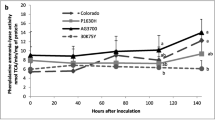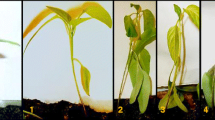Abstract
Varietal resistance of tea towardsBipolaris carbonum was tested following detached leaf inoculation technique. Among the fourteen varieties tested, three were found to be highly susceptible, while other three were resistant. Leaf exudates and diffusates collected from the resistant varieties were more fungitoxic than those from the susceptible ones. Two antifungal compounds isolated from healthy andB. carbonum-infected tea leaves exhibited clear inhibition zones atR F 0.8 and 0.65, respectively, in a chromatographic bioassay. On the basis of their color reaction on TLC and UV-spectra these were identified to be catechin and pyrocatechol. Resistant and susceptible varieties accumulated 439–510 and 187–212 μg/g fresh mass tissue of pyrocatechol, respectively, 2 d after inoculation withB. carbonum, while a low concentration (45–58 μg/g) of this compound was detected in healthy leaf tissue.
Similar content being viewed by others
References
Chakraborty B.N.: A new record of leaf disease of tea (Camellia sinensis (L.) O. Ktze.).Current Sci. 56, 900 (1987).
Chakraborty B.N., Chakraborty U., Saha A.: Isolation and characterization of an antifungal compound from tea leaves challenged withPestalotiopsis theae.Indian Phytopathol. 42, 302 (1989).
Chakraborty B.N., Chakraborty U., Saha A.: Defense strategies of tea (Camellia sinensis) against fungal pathogens, pp. 485–501 inHandbook of Phytoalexin Metabolism and Action (M. Daniel, R.P. Purkayastha, Eds). Marcel Dekker, New York 1994.
Chakraborty B.N., Saha A.: Toxin production byBipolaris carbonum and its effect on tea leaves.Indian Bot. Contractor. 6, 35–37 (1989a).
Chakraborty B.N., Saha A.: Biological activity of leaf diffusates of tea in relation to resistance toBipolaris carbonum.Environ. Ecol. 7, 717–720 (1989b).
Chakraborty B.N., Saha A.: Detection and cellular location of cross reactive antigens shared byCamellia sinensis andBipolaris carbonum.Physiol. Mol. Plant Pathol. 44, 403–416 (1994).
Dickens J.S.W., Cook R.T.A.:Glomerella cingulata onCamellia.Plant Pathol. 38, 75–85 (1989).
Hamaya E., Tsushida T., Nagata T., Nishino C., Enoki N., Manabe S.: Antifungal components ofCamellia plants.Ann. Phytopathol. Soc. Japan 50, 628–636 (1984).
Harborne J.B.:Phytochemical Methods. Chapman and Hall. London 1973.
Hormans A.I., Fuchs A.: Direct bioautography on thin-layer chromatograms as a method for detecting fungitoxic substances.J. Chromatogr. 51, 327–329 (1970).
Kawamura J., Takeo T.: Antibacterial activity of tea catechin toStreptococcus mutans.Nippon Shokuhin Kogyo Gakkaishi 36, 463–467 (1989).
Keen N.T.: Phytoalexins: Efficient extraction from leaves by facilitated diffusion technique.Phytopathology 68, 1237–1239 (1978).
Muller K.O.: Studies on Phytoalexins. I. The formation and the immunological significance of phytoalexin produced byPhaseolus vulgaris in response to infections withSclerotina fructicola andPhytophthora infestans.Austr. J. Biol. Sci. 11, 275–300 (1958).
Nagata T., Tsushida T., Hamaya E., Enoki N., Manabe S., Nishino C.: Camellidins, antifungal saponins isolated fromCamellia japonica.Agr. J. Biol. Chem. 49, 1181–1186 (1985).
Purkayastha R.P., Ray C.: The detection of phytoalexins in jute leaves after infection byColletotrichum corchorum and their possible role in lesion development.Physiol. Plant Pathol. 6, 265–273 (1975).
Sambandam T., Sivaswamy N., Mahadevan A.: Microbial degradation of phenolic substances.Indian Rev. Life Sci. 2, 1–18 (1982).
Sarmah K.C.: Diseases of tea and associated crops in North-East India.Indian Tea Assoc., Memorandum no. 26, 33–40 (1960).
Sinha A.K., Hait G.N.: Host sensitization as a factor in the induction of resistance in rice plants againstDrechslera infection by seed treatment with phytoalexin inducers.Trans. Brit. Mycol. Soc. 79, 213–219 (1982).
Wang Z.N.: Chinese famous teas and their characteristic constituents bioformation.World Tea, Internat. Symp. on Tea Science, Shizuoka (Japan), pp. 23–33 (1991).
Werder J., Kern H.: Resistance of maize toHelminthosporium carbonum: Changes in phenolics and their antifungal activity.J. Plant Dis. Protect. 92, 477–484 (1985).
Williams D.H., Flemming I.:Spectroscopic Methods in Organic Chemistry. Tata McGrow Hill Publ. Co., New Delhi 1988.
Author information
Authors and Affiliations
Rights and permissions
About this article
Cite this article
Chakraborty, B.N., Saha, A. Accumulation of antifungal compounds in tea leaf tissue infected withBipolaris carbonum . Folia Microbiol 39, 409–414 (1994). https://doi.org/10.1007/BF02814448
Received:
Issue Date:
DOI: https://doi.org/10.1007/BF02814448




